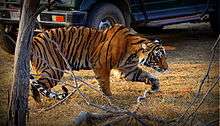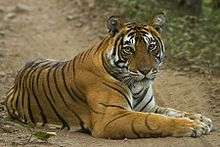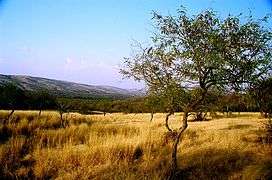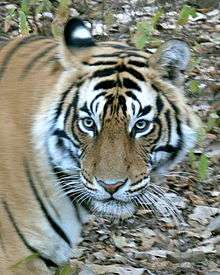Ranthambore National Park
| Ranthambhore National Park रणथंभौर राष्ट्रीय उद्यान | |
|---|---|
|
IUCN category II (national park) | |
|
Ranthambhore National Park | |
 Ranthambhore NP | |
| Location | Sawai Madhopur, India |
| Nearest city | Kota and Jaipur |
| Coordinates | 26°01′02″N 76°30′09″E / 26.01733°N 76.50257°ECoordinates: 26°01′02″N 76°30′09″E / 26.01733°N 76.50257°E |
| Area | 282 km2 (109 sq mi) |
| Established | 1980 |
| Governing body | Government of India, Ministry of Environment and Forests, Project Tiger |

Ranthambhore National Park (Hindi: रणथंभौर राष्ट्रीय उद्यान) or Ranthambhore is the fortieth largest national park in northern India, covering 392 km². Ranthambhore was established as the Sawai Madhopur Game Sanctuary in 1955 by the Government of India and was declared one of the Project Tiger reserves in 1973. Ranthambhore became a national park in 1980. In 1984, the adjacent forests were declared the Sawai Man Singh Sanctuary and Keladevi Sanctuary, and in 1991 the tiger reserve was enlarged to include the Sawai Man Singh and Keladevi sanctuaries.
Ranthambhore wildlife sanctuary is known for its Bengal tigers,[1] and is a popular place in India to see these animals in their natural jungle habitat. Tigers can be easily spotted even in the daytime. The best times for tiger sightings at Ranthambhore National Park are deemed to be in November and May. The park's deciduous forests are characteristic examples of the type of jungle found in Central India. Other fauna include the Indian leopard, nilgai, wild boar, sambar, striped hyena, sloth bear, southern plains gray langur, rhesus macaque, mugger crocodile[1][2] and chital. The sanctuary is home to a wide variety of trees, plants, birds and reptiles, as well as one of the largest banyan trees in India.
It is situated in the Sawai Madhopur district of southeastern Rajasthan, about 110 km northeast of Kota and 140 km southeast of Jaipur, which is also the nearest airport. The nearest town and railway station is at Sawai Madhopur, about 11 km away. The park is also close to the Kota railway station. RIDCOR operates a mega-highway between Kota and Ranthambhore. Ranthambhore National Park lies at the edge of a plateau and is bounded to the north by the Banas River and to the south by the Chambal River. It is named after the historic Ranthambhore fortress, which lies within the park.
Wildlife
Ranthambhore is known for its large tiger population.[3] As park tourism and the population of neighbouring villages increased, there were more frequent fatal human-tiger interactions and poaching. The Indian government started Project Tiger in 1973 and allotted an area of 60 mi2 of the park as a tiger sanctuary. This area later expanded to become what is now the Ranthambhore National Park.
In 2005, there were 26 tigers living in the park. This was significantly lower than the recorded tiger population of the reserve in 1982, which stood at 44. According to non-government sources there were 34 adult tigers in the Ranthambhore National Park in 2008, and more than 14 cubs. This increase was attributed largely to sustained efforts by forest officials to curb poaching. Villagers in the region were being given incentives to stay out of the park, and surveillance cameras were also fitted across the reserve.[4] The Indian government committed US$153 million for these efforts.[4] They were successful enough to make Ranthambhore eligible to participate in the Sariska Tiger Reserve relocation program.[5] The first aerial relocation, of the male tiger (Dara) from Ranthambhore to Sariska, was done on 28 June 2008 by Wing Commander Vimal Raj, using a Mi-17 helicopter. Unfortunately, this translocated tiger died on 15 November 2010 due to poisoning.
Tigers

During the past few years, there has been a decline in the tiger population in Ranthambhore due to poaching and other reasons.[3]
A tigress known as "Lady of the Lakes" was separated from her parents at a very young age because of poaching. The young tigress was named Machli after the mark on her body that resembles a fish. She gave birth to three female cubs, one being dubbed 'Machli - The Junior'. The father of Machli Jr. died early from an unknown disease, as confirmed by forest officer Fateh Singh Rathore. Machli Jr. mated with the male tiger Bumburam and gave birth to two cubs, Slant Ear and Broken Tail. Baccha is believed to be her grandson. At 17 years old, Machli Sr. is the world's oldest tigress. Machli recently went missing, raising concern among forest officials, as hunting is difficult at her age.[6] After twenty-six days Machli was spotted and located by forest officials. Machli's daughter T19(Krishna or Unis) is the current queen tigress of Ranthambhore. In 2014, She gave birth to four cubs fathered by Star or Zalim(she was seen mating with both of them), with three surviving, this cubs are now known as T-84, T-83 and T-85. Machli died on 18 August 2016 at the age 20 years. She became longest living tigress in wild environment recorded till date.

Another popular tigress from Ranthambhore is tigress T39, also known as Mala or Noor. Her name comes from the decorative bead-like stripes on her body. She was born to tigress T-13 and fathered by T-12. In November 2016, she was seen with her fourth litter of two cubs. Noor is 9 years old and her son, T72, or Sultan, is from her first litter and is approximately six years old.
Broken Tail was given international publicity in a film made about his life. He left the park area and traveled from Ranthambore to Darra, where he was killed by a train while crossing the railway tracks. The documentary film called Broken Tail features his last journey and has been shown worldwide on many TV channels, including BBC, PBS, CBC, and RTÉ among others, and won the top awards at two of the world's most prestigious wildlife film festivals.
T - 25 also known as Dollar male or Zalim is another famous tiger in Ranthambhore, he sent observers and tiger researchers in a tizzy when he fathered his 2 female cubs as their mother died of a disease, this two cubs are now knows as Bina 1 and Bina 2 and both were relocated to sariska in november 2012 when they were 2 years old . Till this incident all facts on record stated that male tigers do not play an active part in rearing their cubs.
According to the 2014 census of tigers, there were 62 tigers in Ranthambhore National Park.[7] The number of tigers was 48 in 2013 and 25 in 2005. Due to the recent increase in the number of tigers, the park is planning to transfer a few to other parks, such as Sariska and others.[8]
Features
Forests: The Park terrain alternates between dry deciduous forests and open grassy meadow. The flora of the park includes 539 species of flowering plants.
Tigers: Which can be spotted ambling or basking under the sun.
Safari Rides: Rides are carried out at 6:30 and 14:30. Each ride lasts for about three hours. There are two options of vehicles for the safari: 20 seater open top canter or 6 seater open top gypsy. Each ride costs around INR 900 - 1400 per person. The core park area has been divided into several zones and the safari vehicles go to one of those zones. Visitors often take multiple tours, as tiger spotting is rare. There are many resorts to stay in on the way from Sawai Madhopur to the national park.
Ranthambhore Fort: The majestic fort, built in the 10th century, towers over the entire park area. It stands 700 feet above the surrounding plain. Inside the fort, there are three red Karauli stone temples devoted to Ganesh, Shiva and Ramlalaji. There is a Digamber Jain temple of Lord Sumatinath (5th Jain Tirthankar) and Lord Sambhavanath. The temples were constructed in the 12th and 13th centuries.
Padam Talao: This is the largest of the many lakes located in the park. A red sandstone Jogi Mahal can be found at the edge of the lake. A gigantic banyan tree, considered to be India’s second largest, is also near the lake.
Transportation
Air: Jaipur, 160 km away, is the nearest airport to Ranthambhore wildlife sanctuary.
Rail: Ranthambhore National Park is around 11 km from Sawai Madhopur Railway Station, which lies on the Delhi to Mumbai trunk route. The city is a stop for many trains, including Jaipur - Indore Super Fast, Dayodaya Express (Ajmer - Jabalpur Express), Jodhpur - Indore Intercity, Hazrat Nizamuddin - Indore Express, Marusagar Express (Ajmer - Ernakulam Express / Ernakulam Express), Jaipur - Mysore Express, Jaipur - Chennai Express, Jaipur - Coimbatore Express, Jodhpur - Puri Express, Jodhpur - Bhopal Express, Jodhpur - Indore Intercity, and the August Kranti Delhi to Mumbai Rajdhani Express.
The Jaipur - Indore Super Fast connects Sawai Madhopur to a major city of Madhya Pradesh, Indore Junction. There is also a Kota Jan Shatabdi Express train, from Kota to the national capital of Delhi via Sawai Madhopur. Other trains include Kota - Hanumangarh Express, Sawai Madhopur-Mathura Passenger and Jaipur-Kota Passenger. Kota - Patna Express connects Sawai Madhopur and Patna via Agra, Kanpur, Lucknow and Varanasi.
Luxury trains: The Palace on Wheels, The Royal Rajasthan on Wheels, Maharajas' Express, and The Indian Maharaja make a scheduled stop at Sawai Madhopur on their eight-day round trips to tourist destinations.
Roads : A network of buses connect Sawai Madhopur, the nearest town, to all the major cities within the state of Rajasthan. The frequency of direct services is not very great, however. A car or taxi must be hired from Kota to Ranthambhore. Kota - Ranthambhore is a mega highway and can be covered in 1.5 hours.
Distance chart From Ranthambhore :
Jaipur 130 km
Kota 114 km
Jodhpur 450 km
Bikaner 476 km
Udaipur 401 km
Delhi 365 km
Ajmer 258 km
Mount Abu 555 km
Jaisalmer 713 km
Dausa 109 km
General information

- National Park area: 275 km² core area. 392 km² including buffer zone
- Tiger Reserve area: 334 km². Today it covers an area of 1334 km2. http://www.wwfindia.org/about_wwf/critical_regions/national_parks_tiger_reserves/ranthambore_tiger_reserve/
- Altitude: 215 to 505 meters above sea level.
- Kota Station is a stop for all trains for 10 minutes and connects Sawai Madhopur with almost 50 trains.
- Closest airport is Jaipur, 160 km away.
- Terrain: Dense tropical dry forest, open bushland and rocky terrain interspersed with lakes and streams.
- Ecoregion: Kathiawar-Gir dry deciduous forests.[9]
- Best Season: From November to March.
- Closed: Monsoon season (July - September).
Ecosystem Valuation
An economic valuation of the tiger reserve estimated that its flow benefits are worth 8.3 billion rupees (0.56 lakh / hectare) annually. Gene-pool protection services (7.11 billion), provisioning of water to the neighbouring region (115 million) and provisioning of habitat and refugia for wildlife (182 million) were some of the important services that emanated from the tiger reserve. Other services included nutrient cycling (34 million) and sequestration of carbon (69 million).[10]
Gallery
.jpg) Ranthambhore is famous for its tigers
Ranthambhore is famous for its tigers Three-year-old male named Baccha (Hindi: Child) residing in the reserve
Three-year-old male named Baccha (Hindi: Child) residing in the reserve Sambar deer
Sambar deer Indian wild boar at Ranthambore
Indian wild boar at Ranthambore.jpg) Spotted deer are abundant
Spotted deer are abundant A monkey at the park
A monkey at the park Forest inside the Ranthambhore Fort
Forest inside the Ranthambhore Fort View of Rajbag Lake from Ranthambhore Fort
View of Rajbag Lake from Ranthambhore Fort Ranthambhore Fort
Ranthambhore Fort Male peacock at Ranthambhore
Male peacock at Ranthambhore
See also
References
- 1 2 Nowell, Kristin; Jackson, Peter (1996). "Tiger". Wild Cats: Status Survey and Conservation Action Plan (PDF). Gland, Switzerland: IUCN/SSC Cat Specialist Group. pp. 55–65. ISBN 2-8317-0045-0.
- ↑ Da Silva, A. and Lenin, J. (2010). "Mugger Crocodile" Crocodylus palustris, pp. 94–98 in S.C. Manolis and C. Stevenson (eds.) Crocodiles. Status Survey and Conservation Action Plan. 3rd edition, Crocodile Specialist Group: Darwin.
- 1 2 Sadhu, Ayan; Jayam, Peter Prem Chakravarthi; Qureshi, Qamar; Shekhawat, Raghuvir Singh; Sharma, Sudarshan; Jhala, Yadvendradev Vikramsinh (2017-11-28). "Demography of a small, isolated tiger (Panthera tigris tigris) population in a semi-arid region of western India". BMC Zoology. 2: 16. doi:10.1186/s40850-017-0025-y. ISSN 2056-3132.
- 1 2 "www.time.com/time/magazine/article/0,9171,1813980,00.html".
- ↑ "timesofindia.indiatimes.com/Mate_for_Sariskas_male_tiger_flown_in_from_Ranthambore/articleshow/3199359.cms".
- ↑ "timesofindia.indiatimes.com/home/environment/flora-fauna/Ranthambores-missing-tigress-Machli-found-after-26-days/articleshow/29875506.cms".
- ↑ "Two more cubs spotted in Ranthambore". The Times of India. 29 May 2014. Retrieved 7 July 2014.
- ↑ "24 Tigers 2013 will be shifted from Ranthambhore". Patrika Group (in Hindi). Retrieved 7 July 2014.
- ↑ "Kathiarbar-Gir Dry Deciduous Forests". Terrestrial Ecoregions. World Wildlife Fund. Retrieved 2017-02-14.
- ↑ (PDF) https://web.archive.org/web/20160826050803/http://www.iifm.ac.in/sites/default/files/Newspdf/IIFM-NTCA-REPORT.compressed-min.pdf. Archived from the original (PDF) on 26 August 2016. Retrieved 14 August 2016. Missing or empty
|title=(help)
4. Singh, V. and Shrivastava, A. 2007. Biodiversity of Ranthambhore Tiger Reserve, Rajasthan. Scientific Publishers, Jodhpur. ISBN 81-7233-492-3.
External links
| Wikimedia Commons has media related to Ranthambore National Park. |
| Wikivoyage has a travel guide for Ranthambore National Park. |